June is a great time for gardening. This is the time of the year when most of our annuals and perennials are blooming and in need of dead heading or our vegetable gardens are just beginning to enhance our lives with all the delicious, home-grown produce. It is also a time where we might begin to see problems with some plants due to drought and heat issues. So, I will continue with plants chosen from the Great Plants for the Great Plains team as I write about a drought tolerant plant that will grow very well in Nebraska environments, Freemont’s Primrose.
Fremont’s Primrose, Oenothera macrocarpa ssp. Fremontii, is a subspecies of Missouri Primrose. The subspecies has red stems with silvery foliage and paler yellow flowers. Fremont’s primrose is overall smaller than the straight species, growing up to 10 inches tall and 18 inches wide. It grows with sprawling stems that curve upright at the tips. The leaves are narrow, lanceolate, and are up to 5 inches long with a silvery coloration to the leaves. The flowers are pale yellow with 4 petals that are shaped like a funnel. The flowers close during the middle of the day and open again in the evening, which is why it is called evening primrose. The flowers bloom in June and July and fade to a reddish gold color as they fade out.
Fremont’s Primrose is the 2016 Great Plants for the Great Plains perennial of the year because it is a great selection for Nebraska and the Great Plains states. This plant is very drought-tolerant and is adaptable to many different soil types. It is often planted in rock gardens and other hot, full sun locations that many plants wouldn’t even survive in. This makes it a great choice for Nebraska because it gets very hot and windy later in the summer and this plant will thrive in those conditions. It also make a great selection for Nebraska because it is a plant that is “deer resistant” meaning that the deer don’t typically feed on it which can be a problem for many of our plants on an acreage.
Fremont’s Primrose is a good selection for a pollinator garden as well, pollinator insects such as butterflies and moths are often found visiting it. Hummingbirds will also visit the flowers of primrose for nectar and to eat other insects that are attracted to the plants, according to the USDA, NRCS. The Bureau of Land Management for Plant Select Plants from Colorado states “Evening primroses have edible leaves, roots and shoots”. Many Native American tribes used evening primrose for food and medicines as well as for a tea. So this was a plant that was widely used throughout history and now makes a great addition to your landscape.
Evening primrose is a great plant, but choosing Fremont’s Primrose might fit your landscape a bit better. This selection is the smaller, more silvery choice with paler yellow flowers and distinctly red stems. This would be an attractive choice for any landscape to add a unique and interesting effect, but especially those that are not watered often or in full, hot sun during Nebraska summers. So, the next time you choose a plant for the south or west side of your house or out in the acreage with little water, choose a drought tolerant plant, choose Fremont’s Primrose, the Great Plants for the Great Plains group did.

